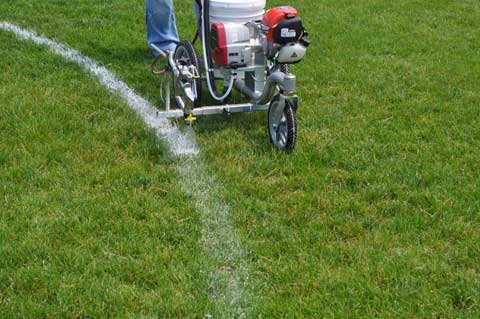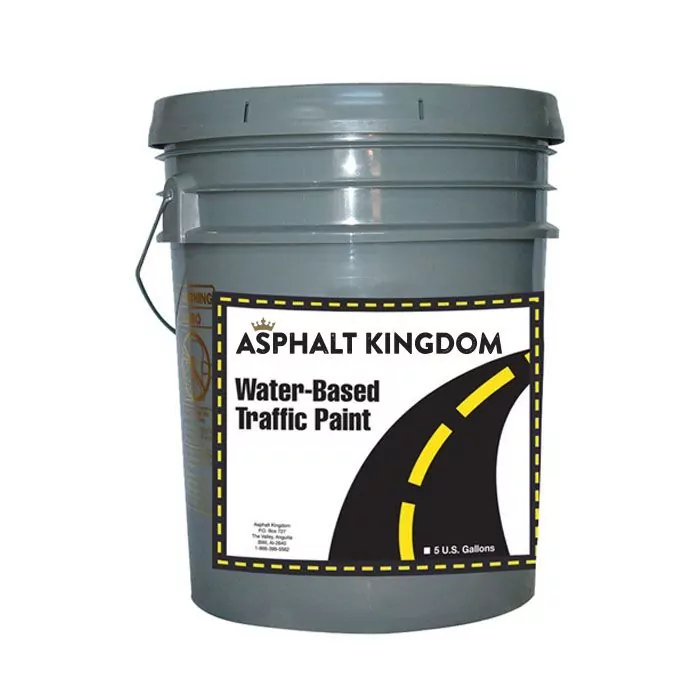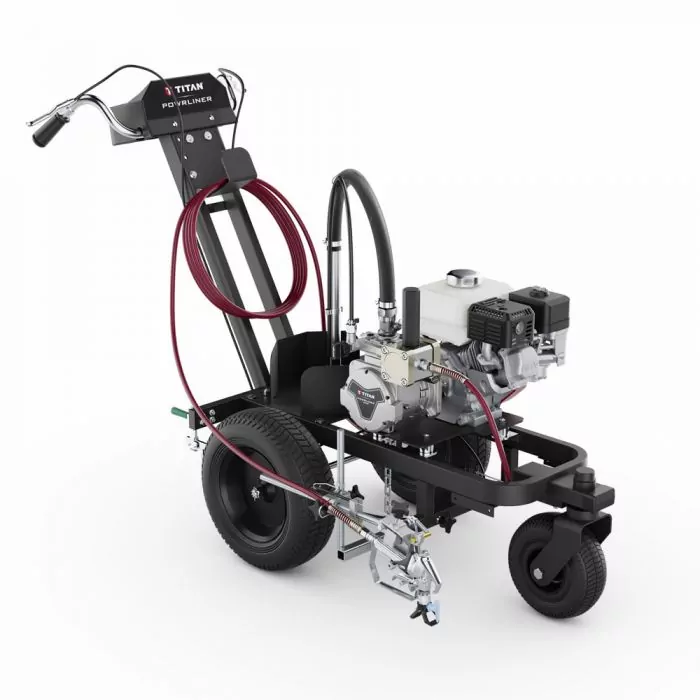Parking lot lines were unheard of at the turn of the 20th century when automobiles first found widespread use. Drivers were free to park just about anywhere, causing traffic jams and accidents.
Road and parking lot lines were introduced in the early 20th century to ensure that drivers can easily and safely navigate the area. When parking lot lines are well-marked on pavement, drivers know how to move efficiently in a parking lot.
Clearly showing traffic direction, areas where parking is not authorized, and which spots are designated for the handicapped help drivers navigate comfortably and safely around a property.
Parking Lot Line Striping Basics
How To Paint Parking Lines
Are you a DIYer or a new contractor venturing into line striping? Then without further ado, here’s a primer on how to paint new parking lines.
There are two ways to paint new parking lines. Check them out below.
- You can use a four-inch paint roller and paint by hand over a chalk line you've drawn. We recommend that you buy a high quality traffic paint to ensure your results will last.
- For a neater, less back-breaking technique, you can use a parking lot line machine to paint straight parking lines on any asphalt or concrete surface. These machines are available in a wide range of sizes depending on how much line striping you're doing.
Line Striping Tools and Equipment
- A chalk line
- A measuring tape
- Buckets of high-quality traffic paint
- A four-inch roller or a line striping equipment
- Your tool box
- Rolls of caution tape
- Traffic cones
- An assortment of parking lot stencils
Asphalt Striping Equipment
Line striping can be done with modern equipment that sprays paint in a fan pattern. The equipment in this case is called an asphalt striping machine (also known as a line stripers or striping machines). The machines vary in price, performance, and capacity, but the good news is all are simple enough to operate even for newbies.
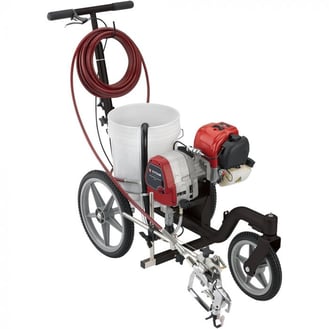 Some stripers are designed for use by small businesses or estate-type homes with larger-than-average driveway parking areas.
Some stripers are designed for use by small businesses or estate-type homes with larger-than-average driveway parking areas.
Others, on the other hand, are designed for use by professionals and property managers, and can cost a few thousand dollars or more.
The difference is in what the machine can do for you in terms of quality, quantity, and efficiency.
Getting To Know Your Line Striper
Whether large or small, all line striping machines basically work the same way. In smaller systems, the machine is often equipped to hold a can or two of aerosol paint. Larger machines, on the other hand, have a bucket with hoses that lead to a sprayer.
Striping machines are equipped with wheels to make it easier for the operator to steer the unit, and by far, professional units are the easiest to steer. Where it is necessary to make sharp turns or gradual curves, these professional machines really shine and give you the best possible result.
When your striping requirements include more complex tasks than just straight lines, maneuverability can be one of the most important factors in choosing your equipment. Especially when it comes to a front wheel that can be locked in for radius lines as well as straight. Just imagine trying to do a curved line on your parking area or sports field without that option.
The units also make it possible to be sure that all the stripes are straight. That’s where locking the front wheel comes in, so there's no danger of you wobbling and weaving your way through your asphalt jungle.
This is one of the keys to professional-looking parking lot paint striping. Without using some kind of parking lot striping machine, the lines are not going to be as straight. Just picture yourself trying to find a straight-edge long enough to guide your brush or roller without knocking it askew, or the wind blowing it away.
Sure, it can be done, but after doing a few stalls, that straight-edge is going to be covered in paint drips that mar the surface every time you move it. You’re much better off having the right equipment to do the job right, or hiring a professional to do the parking lot paint striping for you.
To learn how line striping works and how to choose the best line striping equipment for your application, then watch this video.
How to Choose the Right Line Striper
Parking lot stripers come in all kinds of makes, models, and each with their own bells and whistles. So how can you even begin to choose the right line striping machine from all the various options on the market?
Choosing the Best Line Striping Machine
With all the advances in striping technology over the years, you can get the perfect piece of equipment for your needs.
For instance, in years gone by, you had to buy a conventional machine with an air compressor and a seven-gallon paint pot. Today, though, there are airless sprayers – lighter, with a suction action instead of a compressor – so no heavy air compressor to push around.
The downside? The parts are more expensive than a conventional machine if you are out of warranty. Choose the machine that makes the most sense for your business.
What About Stenciling?
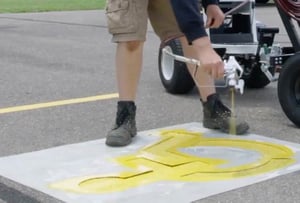 The next step is to evaluate how much striping you will be doing, and whether you will need a line striping machine with full stenciling capabilities or not.
The next step is to evaluate how much striping you will be doing, and whether you will need a line striping machine with full stenciling capabilities or not.
When your job regularly includes the need to mark stencils for arrows, numbers, handicap stalls, and more, make sure to choose a parking lot striper with a detachable spray gun.
You’ll save money over constantly buying spray cans of traffic paint. Don’t forget: some machines come with a two-gun configuration, doubling your stenciling capabilities and giving you the ability to do double-wide lines in a single pass.
Once you’ve decided on stenciling and estimated how much striping you’ll be doing in a year, you’re ready to choose your striper.
In the table below, we’ve laid out the key elements of striping equipment, from the average number of stalls per job, number of jobs per year, to stenciling capacity, and also paint holder.
| Model |
# of stalls per job
|
# of jobs per year
|
Stencilling
|
Paint
|
|---|---|---|---|---|
| AK Asphalt Striping Machine |
No
|
20 oz aerosol cans
|
||
| PowrLiner Line Striping Machine 850 |
<40
|
<12
|
Yes, 1-gun
|
5-gallon pail
|
| PowrLiner Line Striping Machine 3500 |
40-80
|
10-40
|
Yes, 1-gun
|
5-gallon pail
|
| PowrLiner Line Striping Machine 4955 |
All
|
All
|
Yes, 2-gun configuration
|
12-gallon hopper
|
| PowrLiner Line Striping Machine 6955 |
All
|
All
|
Yes, 2-gun configuration
|
12-gallon hopper
|
| PowrLiner Line Striping Machine 8955 |
All
|
All
|
Yes, 2-gun configuration
|
12-gallon hopper
|
There’s more to choosing the right line striping machine for your needs than what the above chart tells you. Buying the right parking lot striper also involves these three major factors that must be a part of your decision.
- Warranty. Warranty should always be the first thing to look at when buying any machinery, as this gives you the best idea of how well a manufacturer stands behind their product.
At Asphalt Kingdom we know how important this is and carry products with the industry’s best and longest warranty. You can usually find the machine's warranty information on the product brochure. But if it doesn't have one, then send us an email and we'll find out for you. - Parking lot striper parts availability. Frankly, a warranty is only as good as its parts availability. Waiting weeks, or months, for a replacement part is simply not acceptable.
That’s why we carry Titan, a brand that has a Quick Response Parts Program. It guarantees the most common repair parts for striping equipment in stock at Titan's 500-plus authorized dealers nationwide, or they’ll ship second day by air. - Add-ons to grow with your needs. Depending on the size of jobs you take on, or look to expand to, check and see which line striping machines have add-ons available.
Our asphalt experts know that if someone is looking forward to adding a drive-behind seat for the ultimate in striping equipment productivity, they need to choose from the PowrLiner 4955, 6955 or 8955 parking lot stripers.
Knowing where you want to expand in the future helps narrow down which machine is best for your needs.
Choosing a line striping machine for your needs is simple when you start by taking a look at your usage.
Are you looking to do your own parking lot once-a-year or do you require your striping equipment to handle large-scale projects every day?
Take stenciling into account as well; do you need it at all, one gun, or two?
Don’t forget to narrow the field down to the best warranty in the industry, guaranteed parts replacement, and add-on options.
Thinking ahead and planning for the future will ensure you get the perfect parking lot striper for the jobs you need to get done.
Asphalt Kingdom has a wide range of line stripers you can choose from should you decide to invest in one. Check out our short list below to know if any of these machines are perfect for you.
A Selection of Asphalt Line Striping Equipment from Asphalt Kingdom
Parking Lot Lines and Paint Colors
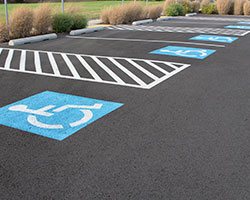 The appearance of the parking lines has much to do with the color and the types of paints chosen.
The appearance of the parking lines has much to do with the color and the types of paints chosen.
Yellow is the traditional color for the stripes, but blue is gaining in popularity in some areas, especially for shopping malls.
In most cases, this is strictly a personal preference or convention, but keep in mind that certain stencils, such as for handicapped stalls, have legal requirements for color, size, and shape.
White is another popular choice for parking lot stripes. Business owners who choose this color may reserve the use of yellow for painting curves and areas where parking is prohibited. Blue with yellow or white is often required by law to paint the handicap symbol on handicap accessible spaces.
Use our AK Paint Calculator to determine the amount of paint you'll need for your line striping job.
There are two basic types of paints used for parking lot paint striping: water-based and solvent-based. Either way, it must be formulated as traffic paint, specifically designed for parking lot paint striping.
Keep in mind that acrylics and latex paints you use to paint walls will not adhere to pavement. They will peel away quickly and all your hard work and planning will be washed away, so make sure that you only use traffic paint.
LEARN MORE: ENROLL IN OUR FREE COURSE
Free Line Striping Email Course
Register Now
Discover how easy it is to save money by striping your parking areas yourself.
A Handy Guide to Reflective Beads
Imagine this: you're driving down the road or navigating a parking lot at night. The area is not well-lit so you can't see the pavement lines. You know the lines are there, but they're so difficult to see. Annoying, isn't it? That's where reflective beads come in handy.
For the very best in visibility, reflective beads are added to the freshly painted lines. Reflective beads are especially useful in areas that have night traffic, snow, or ice.
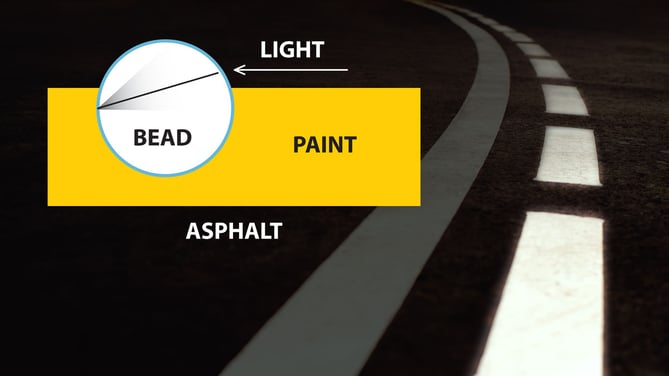
The beads must be added to the freshly painted parking lot paint striping in order to stick.
Once again, applying by hand is nowhere near as efficient and professional-looking as using modern equipment. Whether it’s a hand-held design specifically engineered for reflective beads or an add-on to a striping machine, you’ll get the best result.
Just remember, not all machines have the option to add on an automatic bead dispenser, so ask before you buy!
There are other ways to make parking lot paint striping unique. Just remember that it also needs to be functional.
How to Paint Arrows, Circles, and More
Parking lot stripers are fantastic tools, but are you getting the most from your equipment?
In this section, we will focus on the best ways to use your line striping machine for circles, arrows, and wall markings. After all, using your striping equipment to the fullest is the key to working smarter, not harder.
Circles Made Simple
You know the size circle you need, so how do you get the job done?
Let’s say your circle is 10 yards in diameter. What you need to do is to find your center point, and hammer in a dowel if it’s a field, or have someone hold it firmly if on asphalt pavement or a concrete floor.
Next, take a firmly knotted loop and place it over the stick. Your parking lot striper will now need to be five yards from the center to make a 10-yard circle.
Mark five yards on the rope (leaving excess rope for the knot) and tie off to your line striping machine, or to your chalk. Either way, make sure to have your front caster wheel set for the turning point of the arc.
Test with a dry run before running paint through the striping equipment.
Tip: Make a loop instead of a knot. Otherwise, the rope will wind around the post and get shorter as you execute your turn!
Arrows Done Right
Parking lot stripers with detachable spray gun are easily the best tools for painting arrows on asphalt or any other surface.
Rather than wheeling back and forth over your arrow stencil, this style of line striping machine allows you to make passes with the spray gun by hand.
You can always buy spray cans of traffic paint if your striping equipment does not have a detachable gun.
The key thing about arrows is size and durability. Your best all-around size is a 60-inch arrow.
To get durable markings, do two thin coats of paint allowing each layer to dry completely. A single thick coating is prone to peeling and flaking, ruining all your hard work.
Pro Tip: Have multiple arrow stencils on site always. You don’t have to remove the stencil while it dries, thus saving you time and money.
Walls And Curbs
If walls and curbs are a big part of your work, seriously consider upgrading your parking lot striper to one with a detachable gun. Not only does this save you and your crew time, it is far cheaper than continually buying spray cans of traffic paint.
The main thing here (just like with the arrows) is to apply two thin coats of paint with your striping equipment, not just for long-lasting markings, but also to avoid paint drips running down the wall or curb.
Tips: A 217 spray tip is a good choice for wall markings. Be sure and use extra cardboard around your stencil to protect against overspray from your line striping machine.
Striping equipment is an investment that pays off when you use it to its fullest potential. Get the most from your line striping machine by learning how to use it for circles, arrows, and wall and curb markings, and not just for straight lines.
If you don’t yet have one with a detachable spray gun, consider investing in an upgrade. Now that’s using parking lot stripers to the max!
Creating ADA-Compliant Handicapped Parking Spaces

Striping parking lot lines is a pretty straightforward task, but the same cannot be said of painting handicapped parking spaces. You have to know the right number of accessible and van-accessible parking spaces for a facility, and the right location for these parking spaces.
You also have to learn about handicap-accessible signages, the size of each stall, and specifications for pavement painting. Then there's proper pavement maintenance and other requirements set down by the government regarding handicapped parking spaces.
Whether you're a commercial property owner who's planning to DIY or you're a new asphalt contractor, we've made it easier for you to learn about line striping ADA-compliant handicapped spaces. Read our ADA Handicap Parking Requirements & Cheatsheet to learn more.
LEARN MORE: ENROLL IN OUR FREE COURSE
Free Line Striping Email Course
Register Now
Discover how easy it is to save money by striping your parking areas yourself.
DIY Asphalt Striping for Property Managers
Asphalt striping is not something that you do once and forget about, especially if you want a safe parking lot. What does safety have to do with anything? You see, the lines will fade over time due to sun and the elements.
Regular maintenance requires repainting the stripes occasionally. How often? That depends on two things: climate and the traffic.
Buried under a pile of snow every year? Chances are that snowplows scrape up a lot of line paint along with the ice and snow. Spring repainting is a must.
Also, since regular sealcoating is an important part of maintaining the integrity of your asphalt, you will have to repaint every time the sealant blacks out your line markings. The best-case maintenance is to do this every two to three years.
Did you know? Asphalt lasts between 10 to 30 years, and the difference is how well you maintain it. Click here for the guide that shows you the different steps in proper asphalt maintenance.
If you have a parking lot, does it make sense to invest in the asphalt striping equipment necessary to do the maintenance?
Although the amount charged by contractors to do the job varies, it's still likely to cost you more for a single repainting than it would cost to buy the basic equipment.
Basic Striping Equipment For DIYers
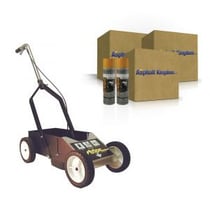 Basic line striping equipment consists of an applicator on wheels. There are small units designed specifically for use by small business owners and larger units designed for professionals or for larger businesses. The least expensive stripers consist of an applicator that holds an aerosol can of spray paint.
Basic line striping equipment consists of an applicator on wheels. There are small units designed specifically for use by small business owners and larger units designed for professionals or for larger businesses. The least expensive stripers consist of an applicator that holds an aerosol can of spray paint.
Usually the paint must be purchased from the same company that sells the striper because of proprietary spray tips, but some may have spray tips compatible with other machines.
Regardless of which brand aerosol paint can you get, you would still be able to apply the paint by hand for curbs and stencils.
The small aerosol line painting machines are designed solely for small jobs, e.g. a parking lot with 10 spaces. Two 20-ounce cans of paint might be enough to do 10 spaces.
The paint manufacturer will have specifications concerning coverage. The sprayers may be adjusted to spray lines that are two inches to four-and-a-half inches wide.
Benefits Of Using Small Asphalt Striping Equipment
- Affordable - The cheapest way to get started without resorting to using a brush or roller and a straight-edge
- Easy-to-use - Any first-timer can easily use this line striping equipment
- The perfect introduction to line striping - Gives you the cheapest option for trying out this type of work to see how simple it is to do
The disadvantage is a big one. This parking lot striper is designed for lots of 10 stalls or less. However, striping equipment is extremely useful for tennis courts, sports fields, and warehouse markings.
You may well find that in time you will invest in a pro line striper and still use the little guy for touch-ups, playgrounds, fields, and courts.
Professional asphalt striping equipment consists of a bucket designed to hold the paint, hoses, wheels and accessories.
The better systems are airless, powered by an engine similar to that of a weed eater. Airless sprayers make neater lines and they usually stay brighter longer. They use water-based paints that clean up easier and dry faster.
Professional Line Striping Equipment For DIYers
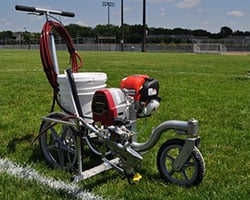 There are many advantages to owning a professional system.
There are many advantages to owning a professional system.
If your parking lot has more than 100 spaces, the maintenance can be done faster. That means the lot will be ready to use in a shorter period of time without concern that someone will drive over the freshly painted lines, smearing them and spreading paint to unwanted areas.
Financially, the benefits are incredibly good. First and foremost, you stop paying someone else to do the work every couple of years.
Now instead of a recurring large cost, you have an investment in asphalt striping equipment. No more budgeting and putting off the cost of having a safe and great looking parking lot; just order the paint and get to work.
Also, instead of paying a contractor, you can do the job yourself, or give the work to your employees, giving them employment instead of an outsider.
A safe, well-laid out parking area also protects everyone who uses it, avoiding costly accidents.
There are more important reasons for having your own line striping equipment than just avoiding paying someone else to do the work.
You can schedule to do the work at the best time for you and your property. Whether it is at night, on the weekend, or during a holiday, you know the best time to get the work done.
After all, as a property manager, you know when closing your parking area is the least disruptive to everyone concerned.
If you own one of the better machines, you can rent it out to other small businesses in your area. You can even make line painting a side business. There are how-to guides online for starting your own parking lot line painting business.
Don't Want to Buy Equipment?
If you don’t have a striper, you will need to hire a contractor. There is simply no way to do more than touch-ups without one.
Keeping your asphalt striping fresh and bright will enhance your customer’s shopping experience and is simply the best reflection on your business.
Contractors! Boost Your Business by Adding Parking Lot Striping
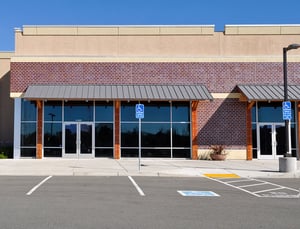 There is no easier way to boost your profit than by adding parking lot striping to your existing sealcoating business.
There is no easier way to boost your profit than by adding parking lot striping to your existing sealcoating business.
Being able to offer this service will dramatically expand the number of jobs available to you.
Suddenly, you have the capacity to handle parking lots for apartments, malls, schools, businesses, and office buildings, as well as line striping football fields, tennis courts, and more.
When you don't offer this service, you are at a disadvantage for bidding on the sealing jobs for these types of locations, as the seal coat will cover up all those existing lines, leaving your client with a situation they need to fix.
Benefits of Offering Parking Lot Line Striping
- Expand your client list and your profits
Providing a complete service with sealcoating and parking lot striping gives you access to a whole new client base.
Think about it: if you are unable to repaint the lines in a parking lot after sealing that means they have to hire a separate contractor to paint. Odds are that outfit also will sealcoat and will get the job instead of you.
We have a free resource on how much you can make with line striping or a premium video that shows you exactly how to price your line striping jobs profitably from Billy Davidson, who has made 6-figure revenues with line striping as a side hustle. - Showcase your professional work
The added benefit of parking lot striping jobs is the perfect showcase of what a professional job your outfit does.
A key part of getting new clients is being able to show them previous work. A neighbor's driveway is a good example; a commercial client or local business is a fantastic one!
From the people passing by who see you working, to the word-of-mouth recommendations, it's a win-win situation when you can add these line striping jobs to your sealcoating business. - Easy to learn and do
In business, time is money, so learning a new skill like parking lot striping is an investment.
Learning how is quick and easy, and our line striping course is free. It covers all you need to know, from a basic intro to the equipment needed, how to prepare the surface to how to price and charge and more. In a nutshell, everything you need to know about painting lines, from start to finish.
In addition, we have an easy calculator to determine exactly how much paint you'll need to get a job done. All in all, this quick course is a minimal investment of your time, and a huge benefit to your sealcoating business. - Support every step of the way
At Asphalt Kingdom, we believe that customer support is our best resource, because our success depends on your success. Our team of line striping experts are available to give you free, experienced and professional advice at 1-866-399-5562, or you can email us. Our business grows only when your business grows, so we're here to help.
Expanding your driveway sealing business to include line painting is a natural fit. It gives you the capacity to tap in to a whole new client base of parking lots, schools, businesses, and other commercial properties.
Having the bragging rights to showcase your professional work is a boost to your reputation and for word-of-mouth. Easy to learn and do, with expert help just a phone call away, parking lot striping is the perfect way to boost your profits.
Parking Lot Line Striping is a Valuable Skill
Everyone is looking for ways to make and save more money, and you could be one of them. If so, we think our free parking lot striping course can help you get started.
Whether you are a property manager looking to save a bucket load of money by doing the line striping yourself, or a sealcoating business eager to land new clients and boost your profits, this knowledge is a fantastic way to line your pockets!
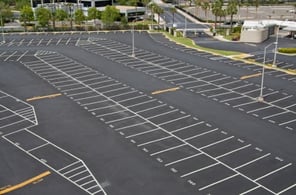 Sealcoating And Parking Lot Line Striping Are A Natural Fit
Sealcoating And Parking Lot Line Striping Are A Natural Fit
Think about it. Applying sealer literally blacks out all paint lines, so they need to be repainted.
Sealing every two years is a crucial part of asphalt maintenance; therefore line striping needs to be done every two years as well. A freshly sealed blacktop looks amazing, and freshly painted parking lot striping will make it look even better.
That’s great news for any building, whether it’s a mall, office building, school, church, or plaza.
It’s An Easy Sell
Putting your best foot forward, and having a professional looking, well-designed parking lot, is an easy sell and easy to do. Property managers who want to save money can easily learn to do this job in-house.
Sealcoating businesses will have a whole new world of clients to pitch to when they add parking lot striping to their list of services.
LEARN MORE: ENROLL IN OUR FREE COURSE
Free Line Striping Email Course
Register Now
Discover how easy it is to save money by striping your parking areas yourself.
We're Here to Help
If you decide to get into line striping, we're here to help! Call us at 1-866-399-5562 or send us a message if you need help choosing your equipment.
